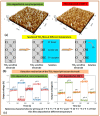Physical-Vapor-Deposited Metal Oxide Thin Films for pH Sensing Applications: Last Decade of Research Progress
- PMID: 37837022
- PMCID: PMC10575361
- DOI: 10.3390/s23198194
Physical-Vapor-Deposited Metal Oxide Thin Films for pH Sensing Applications: Last Decade of Research Progress
Abstract
In the last several decades, metal oxide thin films have attracted significant attention for the development of various existing and emerging technological applications, including pH sensors. The mandate for consistent and precise pH sensing techniques has been increasing across various fields, including environmental monitoring, biotechnology, food and agricultural industries, and medical diagnostics. Metal oxide thin films grown using physical vapor deposition (PVD) with precise control over film thickness, composition, and morphology are beneficial for pH sensing applications such as enhancing pH sensitivity and stability, quicker response, repeatability, and compatibility with miniaturization. Various PVD techniques, including sputtering, evaporation, and ion beam deposition, used to fabricate thin films for tailoring materials' properties for the advanced design and development of high-performing pH sensors, have been explored worldwide by many research groups. In addition, various thin film materials have also been investigated, including metal oxides, nitrides, and nanostructured films, to make very robust pH sensing electrodes with higher pH sensing performance. The development of novel materials and structures has enabled higher sensitivity, improved selectivity, and enhanced durability in harsh pH environments. The last decade has witnessed significant advancements in PVD thin films for pH sensing applications. The combination of precise film deposition techniques, novel materials, and surface functionalization strategies has led to improved pH sensing performance, making PVD thin films a promising choice for future pH sensing technologies.
Keywords: metal oxide; pH sensor; sensitivity; thin film.
Conflict of interest statement
The authors declare no conflict of interest.
Figures






References
-
- Neina D. The Role of Soil pH in Plant Nutrition and Soil Remediation. Appl. Environ. Soil Sci. 2019;2019:5794869. doi: 10.1155/2019/5794869. - DOI
-
- Webster D. pH-Principles and Measurement, Encyclopedia of Food Sciences and Nutrition. 2nd ed. Academic Press; Cambridge, MA, USA: 2003. pp. 4501–4507. Chapter 1. - DOI
-
- Zulkarnay Z., Shazwani S., Ibrahim B., Jurimah A.J., Ruzairi A.R., Zaridah S. An Overview on pH Measurement Technique andApplication in Biomedical and Industrial Process, 2015; Proceedings of the 2nd International Conference on Biomedical Engineering (ICoBE); Penang, Malaysia. 30–31 March 2015.
Publication types
LinkOut - more resources
Full Text Sources

